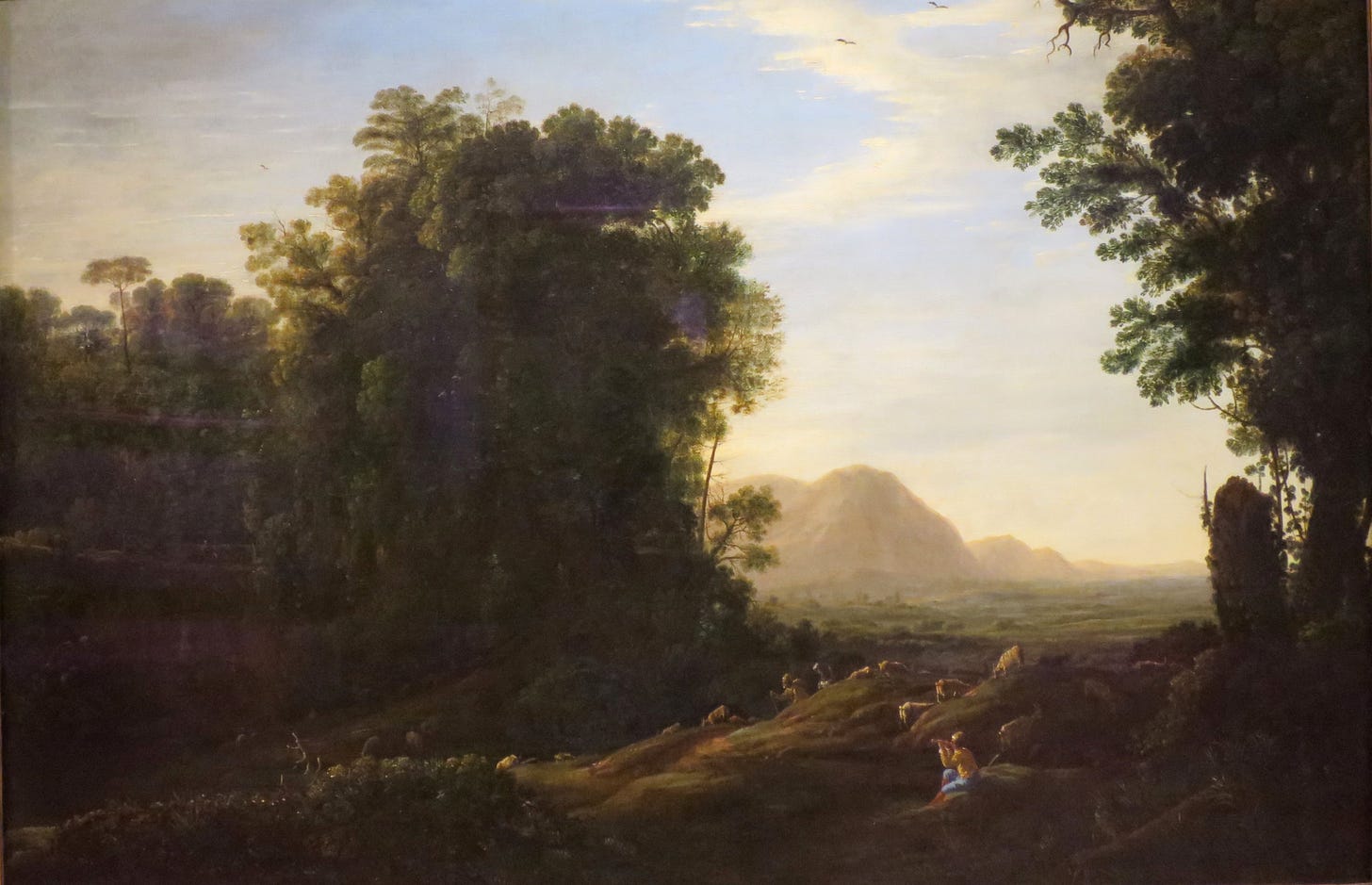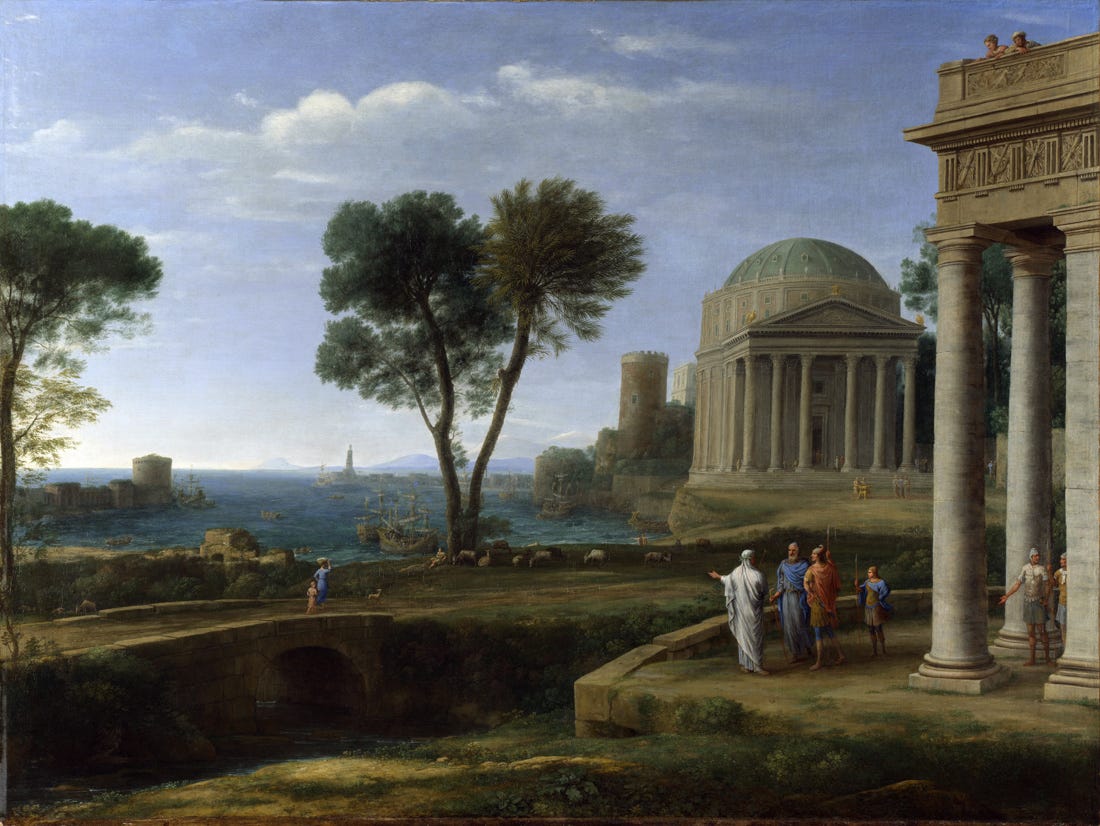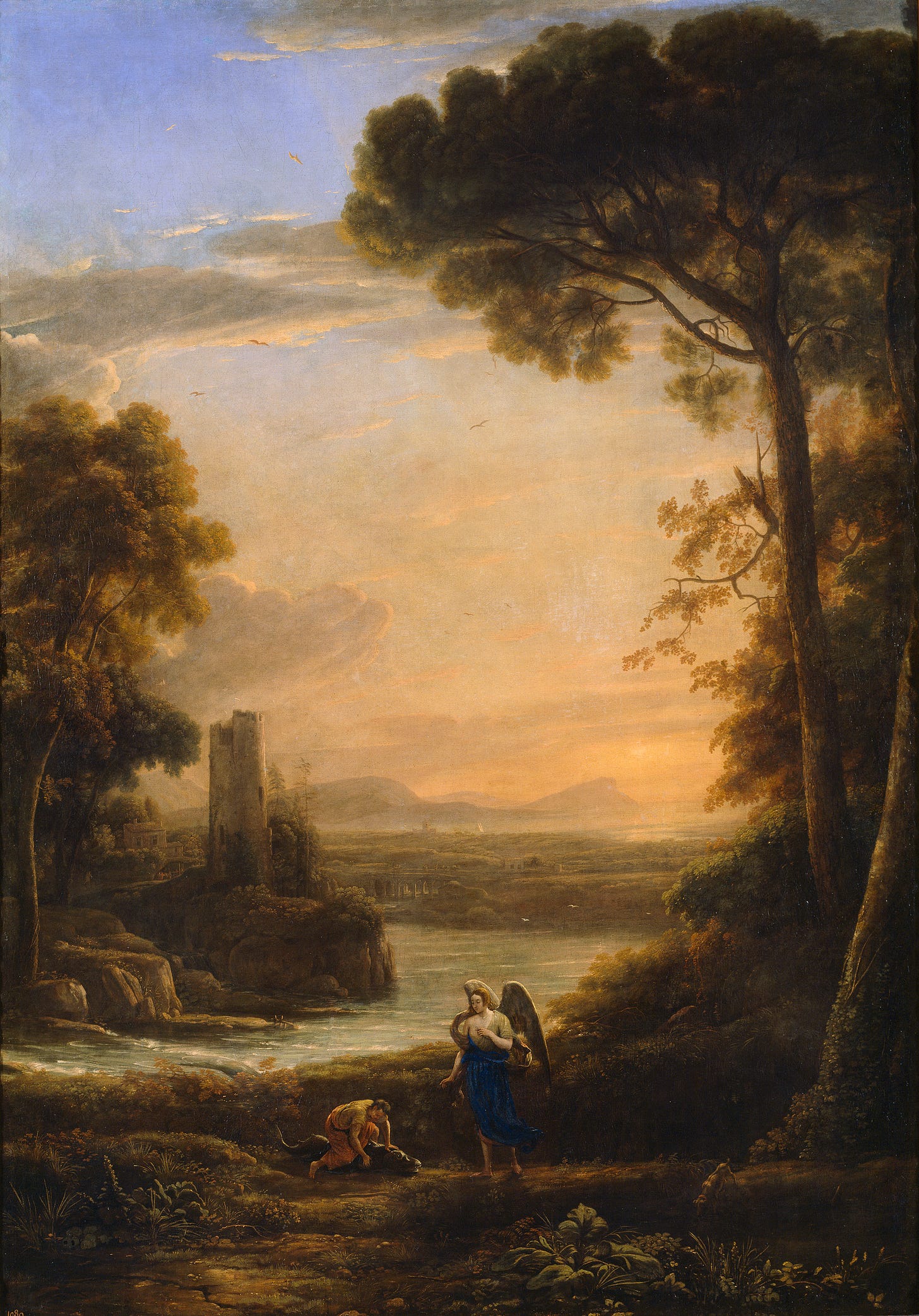Old paintings are, among other things, messages from past times. The landscapes of Claude Lorrain (1600-1682) have the special quality that, already in the painter’s own day, they gave a voice to times seemingly past, to mythic time—and while “mythic subjects” were of course common in old master painting, the vast majority of it consists of multi-figure compositions; Claude (as he is customarily referred to), however, achieves something rarer: he elevates to unseen heights the “lowest form” (as traditionally considered), landscape painting, by fusing it to the “highest subject”, the mythico-biblical scene—i.e.: he did not, like Bellini, Giorgione, Titian, Poussin, etc, use landscape in a mythological painting, he used mythology in a landscape painting—and that made all the difference, all the novelty.
Landscape painters always need a foundation, a “foundational landscape”, to reference. We know that Claude hiked the region surrounding Rome, where he spent his entire working life, in search of motives, images, scenes. We know that he loved to head out to Tivoli with friends, where since Roman antiquity artists and rich patrons spent their summers. Whenever he travelled, he also drew—and perhaps, as some say, he even painted under the open sky, en plein air, the first “impressionist”—before nature. Certain bridges, ruined temples, palaces, columns (“the obsession with pillars”, cf. Benn), certain formations in the landscapes—they are easy to spot in all of his paintings, reused shapes, the painting constructed from reoccuring impressions of the Roman Campagna. But even in his mythic scenes, buildings relatively contemporary to Claude—like the Villa Medici in Rome, or the Villa Farnese in Tivolo—do not distract; seemlessly, Claude integrates them into the Greco-Roman visions, into Ovidian and Vergilian tales. Mere scenery, backdrop, ornament they are not—they could not be removed or replaced: in their inclusion and integration Claude achieves a semantic connection between ancient and modern landscape, ancient history and modern forms. If anything in Claude’s work is ornamental it would be the people inhabiting his landscapes; never is there a sense of genuine motion in them, he does not allow them to disturb the static composition. Claude did not like painting figures, he was not good at it either, and joked that he “sells the landscapes but gives the figures free of charge”. This “blemish” did not hurt his growing popularity in the Rome of the 1630s. The audiences of the high baroque saw in Lorrain a specialist, the specialist, of the landscape—a form otherwise deemed lowly and “Dutch”. Particularly to those non-Italians of wealth and learning—who came to Rome from England, from Spain, from Germany, from France, longing for ancient vistas—favoured Claude; his work, throughout his long working life, sold exceptionally well in these generally quite “picky” circles—a mythical scene, a pastoral, a harbour scene by Claude, the perfect souvenir for the Grand-Tourist.
For us the beauty of a Lorrain-landscape may at first be irritating. Always the same constellations, compositions—always the same beauty. In 1969, there was a large Claude Lorrain-exhibit in London, to where many of his works had been sold over the years, perhaps the largest exhibition of his work to date. Over three dozen Claudes in one location—and the initial critical response?—”Where are the distinctions?” Critics noted that if seen one after another, side by side, Claude’s paintings do not stick in one’s memory, in their similarity they turn to “mush”. A dozen pastorals followed by a dozen harbours. But this is not Claude’s failure—if one looks into the exhibition’s catalogue and reads the list of owners: the Duke of Rutland, the Duke of Buccleuch and Queensberry, the Marquess of Bute, the Earl of Yarborough, the Duke of Northumberland, the Duke of Bedford, the Duke of Sutherland, the Duke of Westminster (here we are perhaps reminded of Peter Ustinov’s anecdote about the Pieter de Hooch scholar in the Earl’s manor discovering a new de Hooch piece and upon asking for its provenance gets the reply “we bought it from the artist”), and so on, one sees that most only own one or two of Claude’s paintings. He did not paint for large exhibitions or even large collections, he did not paint for ten pieces to hang side by side. A shrewd businessman in his repetitions, a master in his speciality, in his “topic”.
Goethe’s insight here is, as always, succinct: “In Claude Lorrain nature declares itself immortal”. And to think that Goethe, who loved Claude, most likely never even saw one of his paintings in person and had to rely on reproductive etchings, like many of his contemporaries. Indeed, art history and criticism as we know them were born from the necessity to explain paintings to people who could not see them in person; the poetic quality of the ekphrasis of Winckelmann, far exceeding anything written today, is due to this: his readers could not just google the works discussed; at best they could rely on monochrome reproductions—some of meagre quality, falsifying the works they aimed to depict. In Goethe’s time, a new edition of the original catalogue of Lorrain, initially published by the painter himself in 1677—to which his biographer Baldinucci gave the grandiose title of “Liber veritatis”—was floating around Europe to great acclaim, despite its flaws. Goethe, upon seeing it, remarked that it “could just as well be called ‘Liber naturae et artis’, for here we see nature and art united in the most beautiful fraternity”. Generously ignoring the cliches forming around Claude’s work, Goethe recognized the “idea at work” in these paintings. In the serene, charming, sublime Claude he found “the highest truth, but no trace of reality”. Claude Lorrain the idealist, who draws from his observations of nature the details to express the “world of his beautiful soul”. The “beautiful soul”, from Shaftesbury to Schiller a favourite topos of 18th-century aesthetic thought; but no aesthetic theory or even knowledge of ancient myth and biblical tales—which Claude possessed only to a certain extent himself—is needed to, as Goethe says, see in these paintings “paradisically pacified longing”, and “timeless fortune”. Some decades after Goethe we have Nietzsche’s remark that in Claude’s work we see unveiled “the bucolic elements of the ancients and their music”—high praise, and indeed: looking at Claude’s landscapes we may feel as if the clouds and trees are about to start singing.
When Nietzsche made this remark, in the latter half of the 19th century, Claude’s works were still seen by collectors and admirers as the perfect symbols of the “fortune of the south”, playing into the “yearning for Italy”, so often seen in German and English letters during that century. And it is in Germany and particularly England that we see, as mentioned, the largest collections of his works today. William Turner admired Lorrain’s light, “gleaming everywhere”, as it pours through the clouds. In the National Gallery in London you can still see two Turners hanging besides two Lorrains, following Turner’s will. But also in France, Corot, the master of Barbizon, drew from Claude—Corotian “nostalgia” on Lorrainian foundations. Swanevelt, Pierre Patel, Lauri, Angeluccio (Claude’s best pupil), John Wootton, George Lambert, George Smith, Richard Wilson, Jacob Moore, Thomas Jones, John Constable, William Turner, John Danby, Caspar David Friedrich, and Camille Corot—perhaps not the most prestigious, but certainly a very productive, and perhaps surprisingly “northern”, lineage.
Nowadays, this love for Claude “in the north” may strike the average person as strange. “The south”, Italy, has lost the mythical splendour that people yearned for and saw expressed so perfectly in Claude’s work: Italy, visited to find art and tradition, idealized as an ordered landscape in which past and present commune. The appreciation of Claude along these lines requires a certain culture of education and cultivation that does no longer exist, and it requires an Italy free of mass-tourism that does no longer exist, and as shown in Claude’s ideal vision only ever did in the minds of better men than we are today.
Claude himself, and perhaps this is why he was able to capture “northern desires” so well, came from Lothringen, or Lorraine, then and now again France; his birthname was Claude Gellee; the assumption of place-based names among Italian painters or painters active in Italy was an old and common tradition. Before he moved to Rome to pursue his talents as a draftsman, which were discovered early by his brother, a printmaker, he worked as an aide in a pie-shop, humble beginnings. When he arrived in Rome, a teenager, he was “inexperienced in the Italian language”. Born poor, and presumably educated poorly, Claude would never fully—as his notes and his will, all written in a mix of Italian and French with constant errors, show—rectify that “inexperience”; knowledge of his subjects and motives he gained quite practically via conversation with educated friends, patrons, and customers—that was enough for the painter. Scholars soon after his death gave Claude the title of “homo illiteratus”, though newer research has shown that he was reading the Bible and the works of Ovid (most likely in French translation)—for a man of his age and standing that would have been a decent enough (literary) education. He learned to paint from the decorative painter Agostino Tassi, and was legally registered in the Roman Guild of St. Luke as Tassi’s apprentice starting from 1619. From 1627 on, Claude had his own household and workshop in Rome. He worked until his death in 1682, despite suffering from gout for decades.
No artist or style arises in a vacuum, and while, as mentioned in the beginning, Claude’s elevation of the landscape was something contemporaries deemed remarkable and new, his work was “merely” the culmination of certain developments in the circles of Roman painting in the early 17th century—of a generation of painters far after Rome’s prime as the capital of painting in the high renaissance, a generation, perhaps forcibly, in touch with and influenced by the developments of Dutch landscape painting. In London—once again we have to look to England in understanding Claude—in the National Gallery, you can see landscapes of Tassi, Claude’s teacher; of Brill and Breenbergh, two Dutch masters who worked in Rome; of Domenichino; of Elsheimer, the most important German painter in Rome during that time; and of Annibale Carracci—in short: of the whole Romano-Northern “scene” that we may consider the foundation, the origin of Claude’s painting. All of these painters already strove for the “ideal landscape”; Breenbergh, I would say, managed to get the closest. Certain techniques and elements of Tassi and Brill—simplified brushwork for foliage, the way birds are painted and placed, groups of trees in generous perspective graduation, etc—are very much visible in Claude. In compositions with a wide perspective and a low-hung horizon Domenichino may have been the immediate model. But all the paintings of the “scene” seem compositionally “antiquated”: independent elements are mechanically assembled, the image seems sewn-together. In Claude this is not the case: the seams are covered with well-placed shrubbery, or are completely sublated: mountains, hills, streams, forests, trees, buildings are aligned in the picture plane as equal parts; distance and proximity, flooded by the same light, work together. Tender and naive details feel rooted in their place, reinforced by their immediate neighbouring element. Spacious and coherent, the “ideal landscape” expands before our eyes; it harbors indistinct shepherds and cows, the Rape of Europa, Juno, Psyche, Aeneas, King David, Jacob and Laban, Hagar and the Angel. Mythology treated mythologically, outside of historical time, distant.
But the timeless and general remains enclosed; the landscape remains, despite all the different mythological scenes, always Arcadian. Behind the hills and clouds waits a world of hidden symmetries, a perfected imagery—open in a wide angle, the spectator is drawn to let the gaze “wander”. The paths, the people, the ships in the distance, the buildings are often not “described” but only implied, loose forms—they rise in the landscape parallel to trees, to hills, to valleys, and the distant and reflecting surface of a body of water: such signs, paths, arches of bridges, in the peaceful impassability indicate the anthropomorphic nature of Claude’s landscapes. Landscapes saturated by human sentiment, all the way up into the tree-tops—but it never goes further than this lyric animation of the land itself. Due to Claude’s ornamental treatment of the human figure the subject itself, the actual scene or event, always remains within the frame of representative order, of ideality, classicity, of a certain staticness.
Claude Lorrain worked for collectors, he worked for travellers, outside of the world of the “official” Roman art of his day, quite comparable to his great compatriot Poussin. But while Poussin tried to visualize myth with great intellectual effort—some would say out of “pagan conscience”—, Claude references ancient scenery in a landscape in which the ancient temple could only ever be a ruin. Cracked columns upon overgrown ground, broken architraves, reliefs and corinthian capitals in the shrubbery. Claude’s Arcadia is one that revels in its Ruinenwert, it’s ruin value; the “ideal landscape” is one in which a sunken antiquity becomes part of the eternity of nature, which then, as an “image-stage”, becomes the locus for reimagined ancient scenes, events that themselves integrate seemlessly into the whole of the landscape—and so always remain fully landscape.
PS: “Lorrain, through the relentless repetition of the same invites—more as gesture than intention—to contemplate all his paintings as one. There is, I would say, only one Lorrain painting, unceasingly masking itself.” (quo my dear friend Kensho)











Excellent article. Lorrain was my first love in painting. I saw his "Seaport" at the National Gallery when I was a teenager. I was spellbound...
This gives so much more substance to his work. Thanks
excellent article, bravo